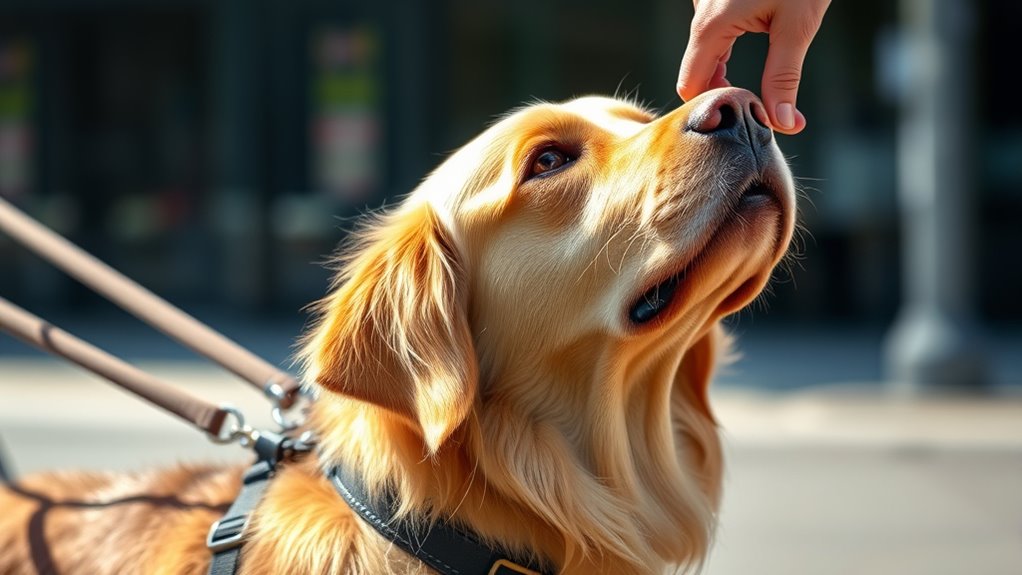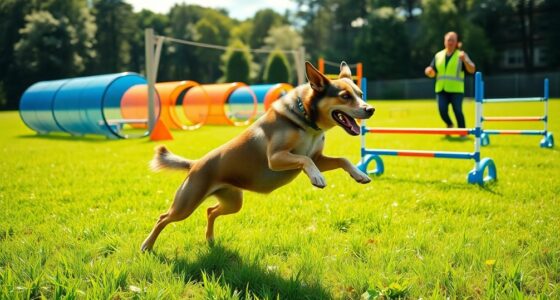Guide dogs learn to lead the blind through specialized training that develops their confidence, focus, and responsiveness. You’ll see them start with basic obedience and social skills, then progress to obstacle detection and navigation commands. They’re trained to make decisions, avoid hazards, and adapt to various environments. Consistent reinforcement and emotional bonding guarantee they perform reliably. If you want to understand how these remarkable animals become trusted guides, there’s more to discover below.
Key Takeaways
- Guide dogs learn to lead by following specific commands and responding reliably to handler cues for safe navigation.
- They are trained to recognize and avoid obstacles through sensory awareness and pattern recognition.
- Socialization and environmental exposure help guide dogs adapt to diverse and unpredictable settings.
- They develop independence and decision-making skills to assess hazards and make safe choices.
- Ongoing reinforcement and bonding ensure guide dogs maintain trust and effective guidance throughout their service.
Selecting the Right Puppies for Guide Dog Training

Choosing the right puppies for guide dog training is an essential first step in ensuring a successful partnership. You need to focus on puppy temperament, as a calm, confident, and adaptable nature helps the dog handle new environments and challenges. When selecting puppies, breeding selection plays a critical role; breeders choose parent dogs with traits that promote intelligence, stability, and friendly demeanor. Observing early behavior can give you insights into their temperament—look for dogs that are curious but not overly excitable. Avoid puppies that show signs of aggression or excessive shyness. By carefully considering breeding and temperament, you set a strong foundation for a guide dog capable of learning and performing reliably in various situations. Additionally, understanding Beginners Guides can provide valuable tips for new handlers to support their puppies effectively. Recognizing puppy temperament early on can significantly influence the success of training and the overall bond between handler and guide dog, especially when early socialization is incorporated into their development. Proper training techniques tailored to individual temperament can further enhance a puppy’s ability to serve effectively, highlighting the importance of consistent training routines in fostering reliable behavior.
Basic Obedience and Socialization Skills
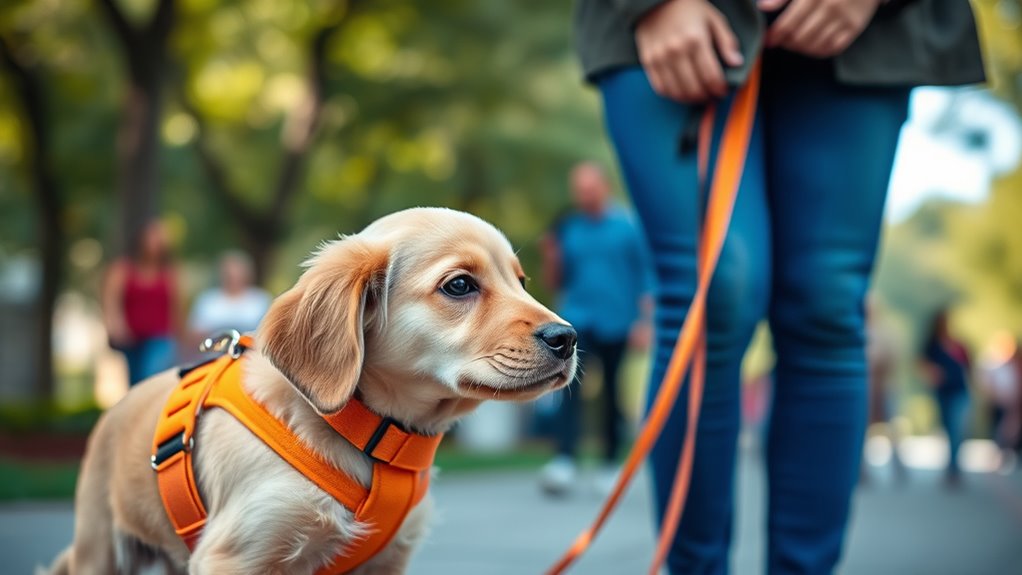
Establishing basic obedience and socialization skills early on is crucial for shaping a reliable guide dog. You’ll focus on leash manners, teaching your dog to walk calmly without pulling or lagging behind. Consistent training helps your dog respond reliably to commands like sit, stay, and heel, which are essential for safe navigation. Socialization is equally important; exposing your dog to various environments, people, and other animals ensures they remain confident and calm in different situations. Incorporate grooming routines into daily life, making your dog comfortable with being handled, brushed, and examined. These routines promote trust and help prevent future behavioral issues. Building these foundational skills early prepares your dog for more advanced training and ensures they become dependable guide companions. Additionally, understanding the trustworthiness of AI models emphasizes the importance of reliable training methods, similar to how AI safety relies on robust safety measures. Recognizing the significance of color accuracy in visual environments can also help handlers better interpret their dog’s responses in different lighting conditions, ensuring effective guidance. Incorporating layered textures and colors during socialization can further boost adaptability in diverse settings.
Specialized Training in Navigation and Obstacle Avoidance
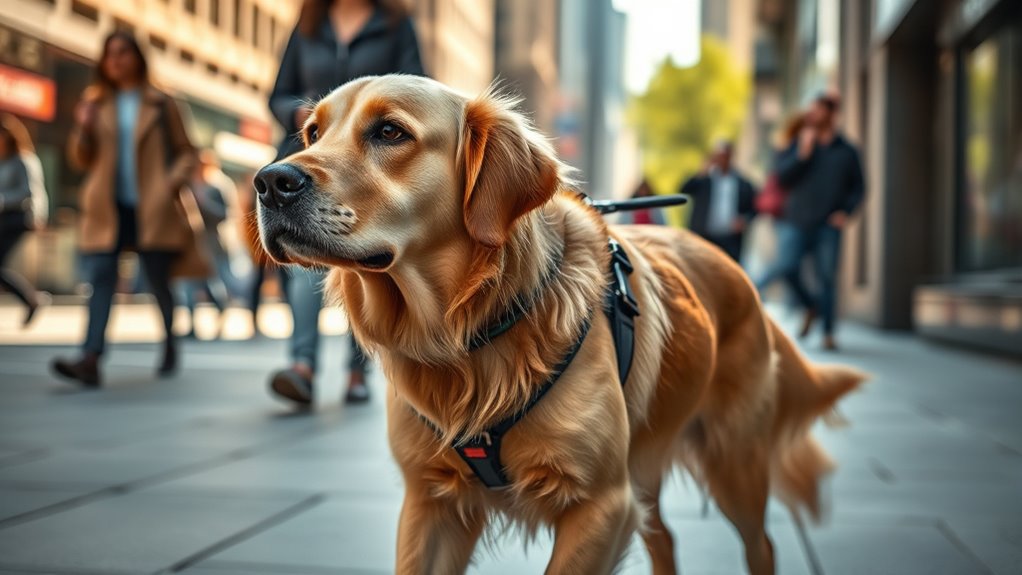
You’ll learn how service dogs are trained to detect obstacles using specialized techniques that keep their handlers safe. They also master navigational commands to confidently move through busy or unfamiliar environments. With adaptable skills for different settings, these dogs help their owners navigate daily challenges with ease.
Obstacle Detection Techniques
Obstacle detection techniques are essential components of specialized training that enable service dogs to navigate complex environments safely. You rely on sensory augmentation, where your dog enhances its natural senses to identify obstacles more effectively. Through consistent training, your dog learns obstacle pattern recognition, allowing it to interpret common obstacle arrangements and anticipate potential hazards. This process helps your dog differentiate between temporary objects, like a moving person, and static barriers, such as curbs or furniture. Your dog develops the ability to respond swiftly to detected obstacles, guiding you smoothly around them. By honing these skills, your service dog becomes a highly reliable partner, ensuring your safety and confidence in unfamiliar or crowded settings. These techniques form the foundation of effective obstacle avoidance during your daily travels. Incorporating rendering lard techniques can also improve your dog’s health and stamina, supporting its ability to perform complex tasks efficiently. Additionally, understanding environmental acoustics can enhance your dog’s obstacle detection, making it more adept at navigating diverse settings. Regular exposure to varied environments can further refine your dog’s navigation skills, ensuring adaptability in new or unpredictable situations. Recognizing the importance of vibrational awareness enables your dog to better interpret subtle cues in its surroundings, enhancing safety. As the integration of automation technologies advances, training methods continue to evolve, further improving service dog performance.
Navigational Command Training
Building on your dog’s ability to detect obstacles, training in navigational commands helps you communicate precise directions to maneuver through complex environments. You learn to give commands like “forward,” “left,” and “right,” enabling smooth navigation. As technology advances, future innovations such as GPS integration and obstacle sensors may enhance this training, but ethical considerations remain vital to ensure your dog’s well-being. Incorporating good lighting and clear visual cues can also support your dog’s understanding of commands. Regular practice during bank hours can improve your dog’s responsiveness and confidence in real-world situations. Additionally, understanding animal training techniques can further refine your approach and improve your dog’s learning process. Staying informed about retail hours can help you plan your training sessions around local store schedules if needed for specialized equipment or supplies.
Environmental Adaptability Skills
Environmental adaptability skills are essential for service dogs to effectively navigate diverse and unpredictable settings. You rely on their ability to integrate sensory information, which enhances environmental perception. By honing these skills, your dog learns to interpret sounds, smells, and visual cues that signal obstacles or changes in terrain. This sensory integration allows them to adapt quickly to new environments, whether busy streets or quiet parks. Through specialized training, they become proficient at obstacle avoidance, recognizing hazards and adjusting their path accordingly. These skills help your guide dog maintain safety and confidence, even in unfamiliar surroundings. Additionally, understanding family dynamics and cultural heritage can influence a dog’s behavior and adaptability in different settings. Moreover, consistent exposure to varied environments during training can further improve their environmental responsiveness, ensuring they remain calm and focused regardless of external distractions. Developing problem-solving skills enables your dog to handle unexpected challenges more effectively. Recognizing the importance of sensory cues from different sources allows your guide dog to better interpret and respond to complex situations. Leveraging AI security technologies during training can also aid in monitoring and enhancing a dog’s adaptive responses. Ultimately, environmental adaptability ensures your dog can lead you smoothly and securely, regardless of what challenges the environment presents.
Teaching Commands and Cues for Safe Movement
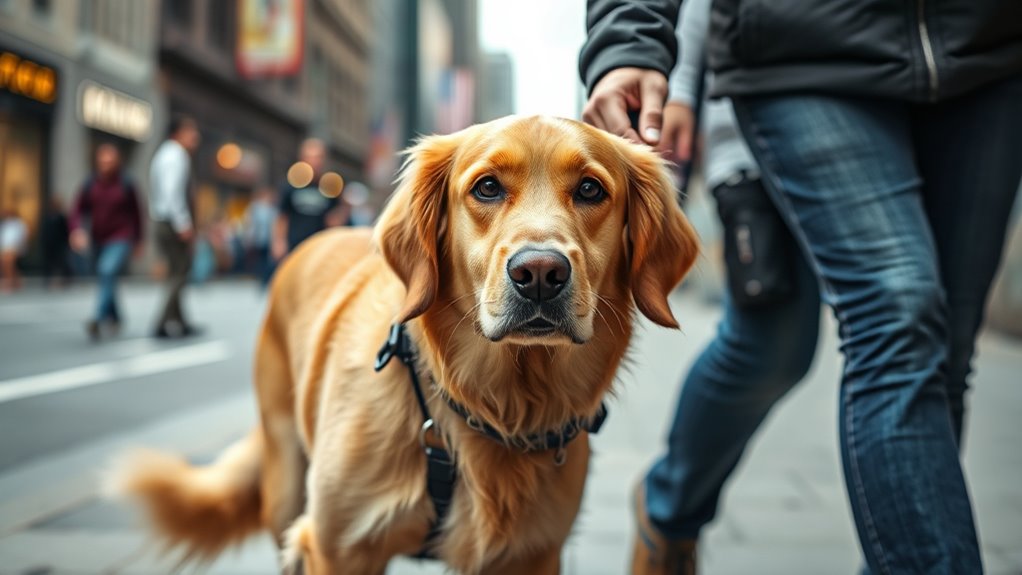
Teaching your service dog commands and cues for safe movement is essential for making certain they can reliably guide you through various environments. Start with foundational skills like hand signal training, which helps your dog respond quickly and clearly. Incorporate scent training to reinforce cues and enhance their awareness of surroundings. Focus on these key areas:
- Teach specific commands for stopping, turning, and steering obstacles.
- Use consistent hand signals paired with verbal cues to improve communication.
- Practice scent training to help your dog identify and respond to important environmental cues.
- Selecting a preppy dog name that matches your dog’s personality can boost your training bond and motivation.
These methods help your dog understand how to guide you safely, respond promptly, and adapt to different situations. Clear, consistent training builds trust and guarantees effective guidance in any setting.
Developing Independence and Decision-Making Abilities
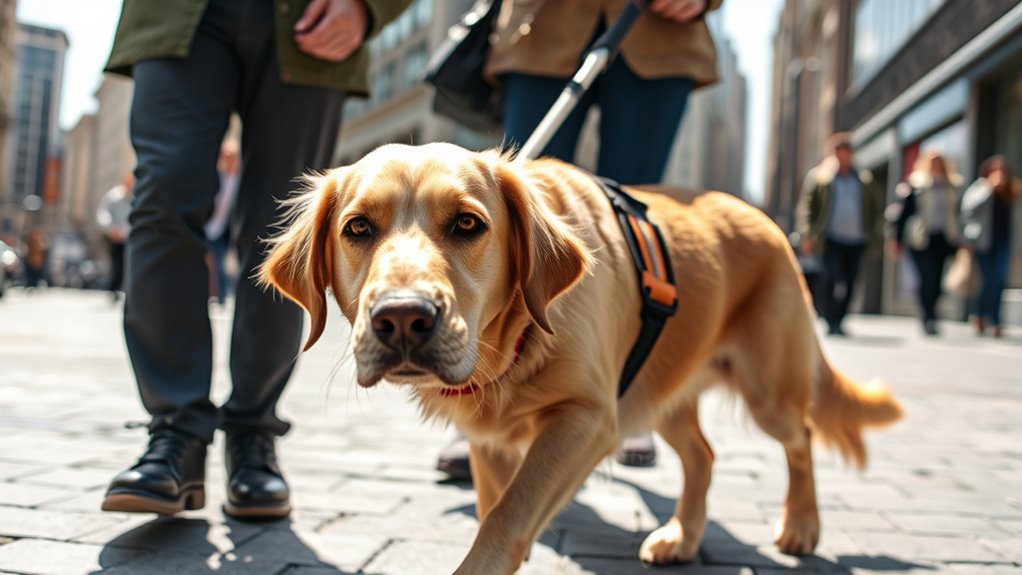
Developing your service dog’s independence and decision-making skills is crucial for ensuring they can handle unexpected situations confidently. Encouraging independent thinking helps your dog assess their environment and make appropriate choices without constant guidance. Practice scenarios where the dog must decide whether to navigate around obstacles or wait for further cues. Reinforce decision-making skills by rewarding confident actions and calmly correcting hesitation. Allow your dog to explore safe environments to build trust in their judgment. Building this independence ensures they won’t rely solely on commands but can adapt to real-world challenges. Consistent training that emphasizes decision-making fosters a confident, capable service dog. Understanding training techniques that promote autonomy is essential for effective skill development. Incorporating behavioral assessments can help identify areas where your dog may need additional support to enhance their confidence. Ultimately, empowering your dog with these skills helps them lead more effectively and supports your independence as a handler. Additionally, positive reinforcement plays a vital role in encouraging your dog’s autonomous decision-making abilities, reinforcing their confidence in their own judgment.
Assessing Readiness for Advanced Training
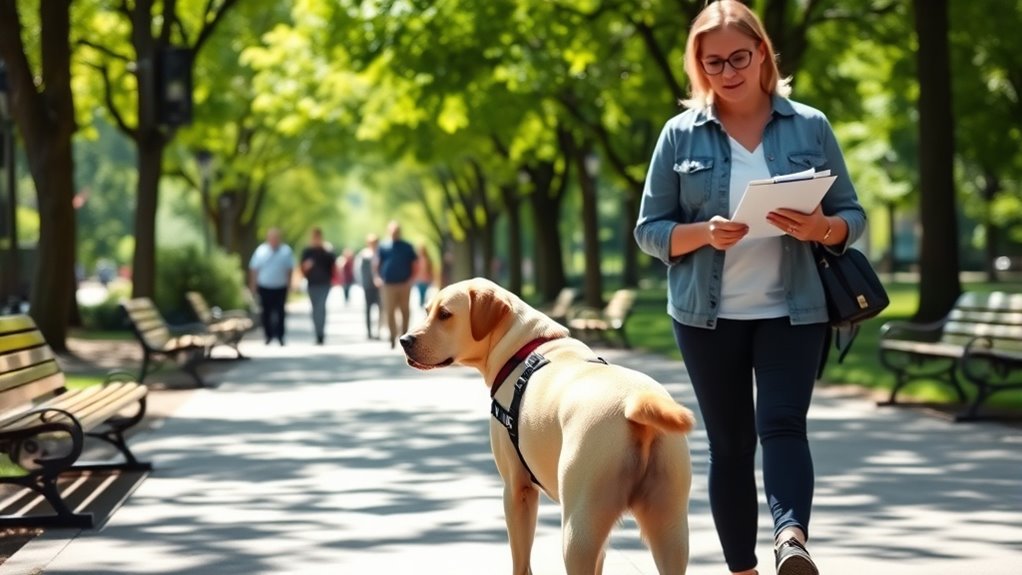
Once your service dog demonstrates consistent independence and sound decision-making skills, it’s time to evaluate their readiness for advanced training. Focus on three key areas:
- Emotional bonding – Ensure your dog demonstrates a strong connection and trust, which is essential for effective communication during complex tasks.
- Scent training – Confirm they can reliably identify and follow scents, a critical skill for guiding their handler in various environments.
- Behavioral stability – Observe their ability to stay calm and focused in different settings, indicating they’re prepared for more challenging tasks.
If your dog shows progress in these areas, they’re likely ready to move forward. This assessment helps determine if they’re emotionally prepared and technically equipped for the next stage of their journey.
Matching Dogs With Handlers and Personalizing Training
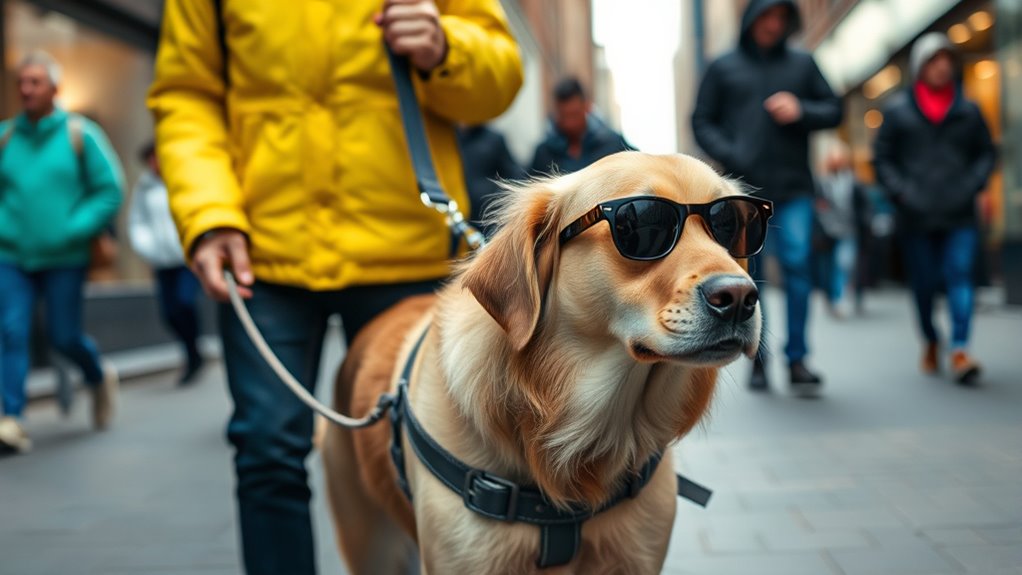
How do you guarantee that a service dog is the right fit for their handler? It starts with evaluating emotional bonding and handler compatibility. During matching, trainers observe how the dog responds to different personalities and environments, ensuring they can connect emotionally. Similarly, they assess whether the dog’s temperament aligns with the handler’s needs, lifestyle, and walking pace. Personalizing training is key—adapting commands and routines so the dog understands specific cues and expectations. This process helps strengthen the bond, creating trust and confidence. When the right match is made, the emotional connection grows, making the dog more effective and responsive. Ultimately, this careful pairing ensures the guide dog can confidently lead and support their handler through daily challenges.
Continuous Support and Reinforcement Throughout a Guide Dog’s Life

After matching a guide dog with their handler, ongoing support and reinforcement become essential to guarantee the partnership remains strong and effective. Regular emotional support helps both of you stay connected and motivated. Additionally, consistent training through therapy sessions keeps the dog’s skills sharp and reinforces good behavior. To maintain progress, consider these key practices:
Ongoing support and regular training are vital for a strong, effective guide dog partnership.
- Schedule periodic refresher training and therapy sessions
- Provide emotional support during stressful or challenging times
- Reinforce training with positive feedback and rewards
Frequently Asked Questions
How Long Does It Typically Take for a Guide Dog to Complete Training?
Training a guide dog usually takes about 18 to 24 months. During this time, you’ll see puppy socialization early on, helping the dog become comfortable with various environments. As they grow, they reach key training milestones like basic obedience and obstacle avoidance. You’re actively involved in this process, ensuring your dog develops the skills needed to safely lead and assist, making the journey rewarding for both of you.
What Health Considerations Are Critical During a Guide Dog’s Development?
Did you know that proper health during a guide dog’s development boosts their success rate? You should prioritize nutrition planning and regular health screenings to guarantee they grow strong and healthy. Critical considerations include monitoring their weight, dental health, and vaccinations. By focusing on these, you help prevent issues that could impair their ability to serve effectively, giving them the best chance to become reliable, well-rounded guide dogs.
How Are Guide Dogs Matched With Their Specific Handlers?
When matching guide dogs with handlers, you consider handler compatibility and conduct a thorough temperament assessment. You evaluate the dog’s personality, energy level, and behavior to make certain they suit your lifestyle and needs. This process helps establish a strong partnership, where both of you feel comfortable and confident. By carefully pairing dogs and handlers, you create a seamless connection that enhances mobility and independence for the person relying on the guide dog.
What Are Common Behavioral Challenges in Guide Dog Training?
You’ll face common behavioral challenges like distraction management and impulse control during guide dog training. It’s essential to teach your dog to stay focused despite distractions and resist impulsive actions. Consistent training helps your dog learn to ignore unnecessary stimuli and wait patiently. With patience and positive reinforcement, you can help your guide dog develop strong impulse control, ensuring they remain reliable and confident while leading you safely.
How Do Guide Dogs Adapt to Changing Environments Over Their Service Life?
You might wonder how guide dogs adapt to changing environments throughout their service life. They develop strong environmental adaptability through ongoing training reinforcement, which helps them stay confident and responsive in new settings. Trainers regularly update their skills, exposing them to diverse situations. This continuous reinforcement ensures guide dogs remain reliable, effectively steering unfamiliar or evolving environments, and maintaining their ability to lead their handlers safely and confidently.
Conclusion
As you guide your dog through their training journey, remember that patience and consistency are key—like a trusty steed in a knight’s quest. With each step, you’re helping them become more confident and capable, ready to lead their handler safely through life’s adventures. When you see your dog navigate obstacles with ease, it’s like witnessing a hero in action. Together, you’ll forge a bond that’s truly a modern-day fairy tale come to life.

